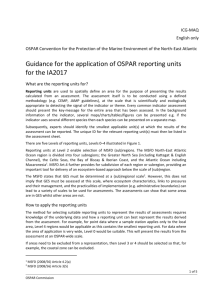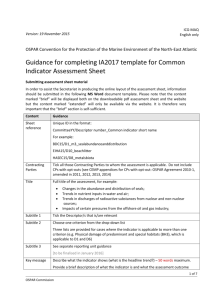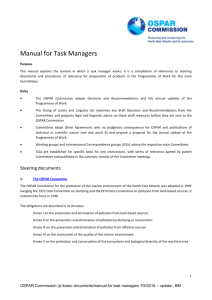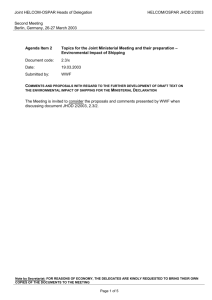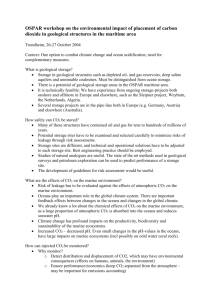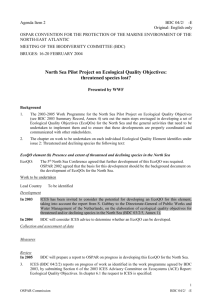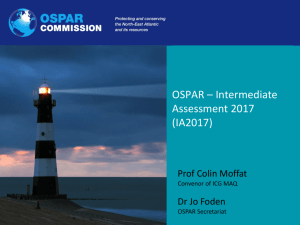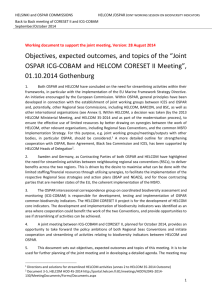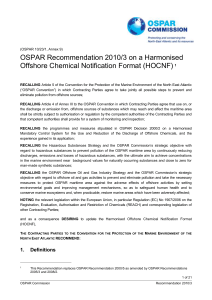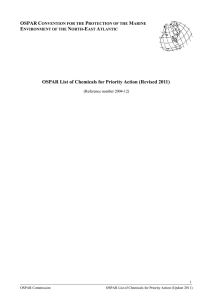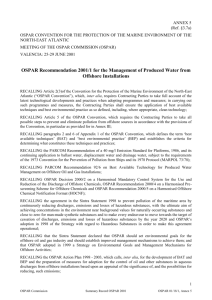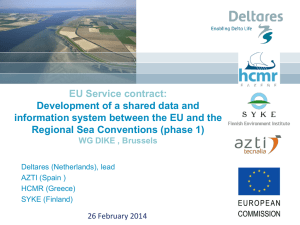description - Naturvernforbundet
advertisement
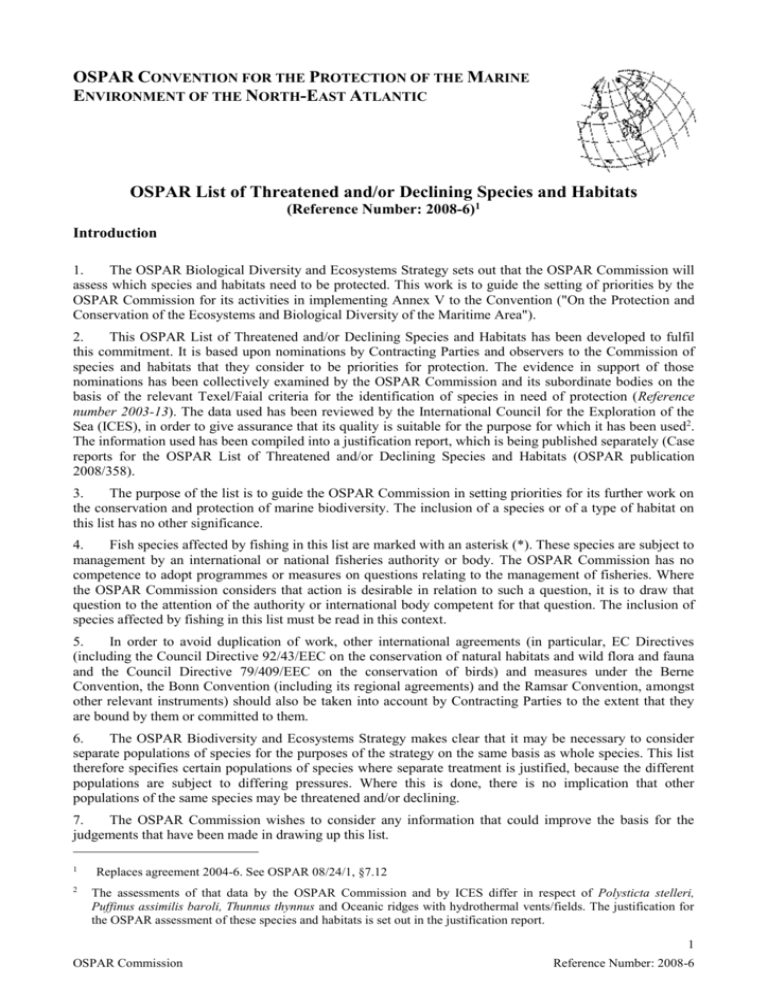
OSPAR CONVENTION FOR THE PROTECTION OF THE MARINE ENVIRONMENT OF THE NORTH-EAST ATLANTIC OSPAR List of Threatened and/or Declining Species and Habitats (Reference Number: 2008-6)1 Introduction 1. The OSPAR Biological Diversity and Ecosystems Strategy sets out that the OSPAR Commission will assess which species and habitats need to be protected. This work is to guide the setting of priorities by the OSPAR Commission for its activities in implementing Annex V to the Convention ("On the Protection and Conservation of the Ecosystems and Biological Diversity of the Maritime Area"). 2. This OSPAR List of Threatened and/or Declining Species and Habitats has been developed to fulfil this commitment. It is based upon nominations by Contracting Parties and observers to the Commission of species and habitats that they consider to be priorities for protection. The evidence in support of those nominations has been collectively examined by the OSPAR Commission and its subordinate bodies on the basis of the relevant Texel/Faial criteria for the identification of species in need of protection (Reference number 2003-13). The data used has been reviewed by the International Council for the Exploration of the Sea (ICES), in order to give assurance that its quality is suitable for the purpose for which it has been used2. The information used has been compiled into a justification report, which is being published separately (Case reports for the OSPAR List of Threatened and/or Declining Species and Habitats (OSPAR publication 2008/358). 3. The purpose of the list is to guide the OSPAR Commission in setting priorities for its further work on the conservation and protection of marine biodiversity. The inclusion of a species or of a type of habitat on this list has no other significance. 4. Fish species affected by fishing in this list are marked with an asterisk (*). These species are subject to management by an international or national fisheries authority or body. The OSPAR Commission has no competence to adopt programmes or measures on questions relating to the management of fisheries. Where the OSPAR Commission considers that action is desirable in relation to such a question, it is to draw that question to the attention of the authority or international body competent for that question. The inclusion of species affected by fishing in this list must be read in this context. 5. In order to avoid duplication of work, other international agreements (in particular, EC Directives (including the Council Directive 92/43/EEC on the conservation of natural habitats and wild flora and fauna and the Council Directive 79/409/EEC on the conservation of birds) and measures under the Berne Convention, the Bonn Convention (including its regional agreements) and the Ramsar Convention, amongst other relevant instruments) should also be taken into account by Contracting Parties to the extent that they are bound by them or committed to them. 6. The OSPAR Biodiversity and Ecosystems Strategy makes clear that it may be necessary to consider separate populations of species for the purposes of the strategy on the same basis as whole species. This list therefore specifies certain populations of species where separate treatment is justified, because the different populations are subject to differing pressures. Where this is done, there is no implication that other populations of the same species may be threatened and/or declining. 7. The OSPAR Commission wishes to consider any information that could improve the basis for the judgements that have been made in drawing up this list. 1 2 Replaces agreement 2004-6. See OSPAR 08/24/1, §7.12 The assessments of that data by the OSPAR Commission and by ICES differ in respect of Polysticta stelleri, Puffinus assimilis baroli, Thunnus thynnus and Oceanic ridges with hydrothermal vents/fields. The justification for the OSPAR assessment of these species and habitats is set out in the justification report. 1 OSPAR Commission Reference Number: 2008-6 8. This OSPAR List of Threatened and/or Declining Species and Habitats will be subject to further development. Species and habitats will be added to or removed from the list, in the light of changes to their conservation status and to the threats they face and in the light of the latest scientific assessments, according to the Texel/Faial criteria. 9. The footnotes form an integral part of the list. PART I : SPECIES Common name SCIENTIFIC NAME English French OSPAR Regions3 OSPAR Regions3 where where the species the species is under occurs threat and/or in decline INVERTEBRATES Ocean quahog Cyprine d'Islande (Praire d’Islande) (Clam d’Islande) I, II, III, IV II Azorean barnacle Balane des Azores V All where it occurs Dog whelk Pourpre petite pierre All II, III, IV Ostrea edulis Flat oyster Huître plate I, II, III, IV II Patella ulyssiponensis aspera Azorean limpet Patelle des Azores V All where it occurs Lesser black-backed gull Goéland brun I All where it occurs Larus fuscus fuscus Pagophila eburnea Ivory gull Mouette blanche I All where it occurs Polysticta stelleri Steller's eider Eider de Steller I All where it occurs Puffinus assimilis baroli (auct.incert.) Little shearwater Puffin de Macaronésie V All where it occurs Puffinus mauretanicus Balearic shearwater Puffin des Baléares II, III, IV, V All where it occurs Rissa tridactyla Black-legged kittiwake Mouette tridactyle I, II, III, IV, V I, II Sterna dougallii Roseate tern Sterne de dougall II, III, IV, V All where it occurs Uria aalge – Iberian population (synonyms: Uria aalge albionis, Uria aalge ibericus) Iberian guillemot Guillemot de Troïl IV All where it occurs Uria lomvia Thick-billed murre Guillemot de Brünich I All where it occurs Arctica islandica Megabalanus azoricus Nucella lapillus BIRDS 3 The OSPAR Regions are: I - the Arctic: the OSPAR maritime area north of latitude 62°N, but also including Iceland and the Færoes; II - the Greater North Sea: the North Sea, the English Channel, the Skagerrak and the Kattegat to the limits of the OSPAR maritime area, bounded on the north by latitude 62°N, on the west by longitude 5°W and the east coast of Great Britain, and on the south by latitude 48°N; III - the Celtic Seas: the area bounded by, on the east, longitude 5°W and the west coast of Great Britain and on the west by the 200 metre isobath (depth contour) to the west of 6°W along the west coasts of Scotland and Ireland; IV - the Bay of Biscay/Golfe de Gascogne and Iberian coasts: the area south of latitude 48°N, east of 11°W and north of latitude 36°N (the southern boundary of the OSPAR maritime area); V - the Wider Atlantic: the remainder of the OSPAR maritime area. 2 OSPAR Commission Reference Number: 2008-6 Common name SCIENTIFIC NAME OSPAR Regions OSPAR Regions where where the species the species is under occurs threat and/or in decline FISH *Acipenser sturio Sturgeon Esturgeon d’Europe Allis shad Alose vraie ou Grande Alose *Alosa alosa II, IV All where it occurs II, III, IV All where it occurs I, II, III, IV All where it occurs All All where it occurs IV, V All where it occurs European eel Anguille européenne *Centroscymnus coelolepis Portuguese dogfish Pailona commun *Centrophorus granulosus Gulper shark Squale-chagrin commun *Centrophorus squamosus Leafscale gulper shark Petit squale All All where it occurs *Cetorhinus maximus Basking shark Requin pèlerin All All where it occurs Coregonus lavaretus oxyrinchus (Linnæus, 1758) Houting Corégone oxyringue II All where it occurs *Dipturus batis (synonym: Raja batis) Common Skate Pocheteau gris All All where it occurs *Raja montagui (synonym: Dipturus montagui) Spotted Ray Raie douce II, III, IV, V All where it occurs *Gadus morhua– populations in the OSPAR regions II and III4 Cod Cabillaud (morue) All II, III Hippocampus guttulatus (synonym: Hippocampus ramulosus) Long-snouted seahorse Cheval de mer(hippocampe) à long bec II, III, IV, V All where it occurs Hippocampus hippocampus Short-snouted seahorse Cheval de mer (hippocampe) à museau court II, III, IV, V All where it occurs *Anguilla anguilla *Hoplostethus atlanticus Orange roughy Hoplostète orange I, V All where it occurs *Lamna nasus Porbeagle Requin taupe All All where it occurs Petromyzon marinus Sea lamprey Lamproie marine I, II, III, IV All where it occurs *Raja clavata Thornback skate / ray Raie bouclée I, II, III, IV, V II *Rostroraja alba White skate Raie à bec pointu II, III, IV All where it occurs *Salmo salar Salmon Saumon de l’Atlantique I, II, III, IV All where it occurs5 *Squalus acanthias [Northeast Atlantic] spurdog Aiguillat commun All All where it occurs *Squatina squatina Angel shark Ange de mer II, III, IV All where it occurs *Thunnus thynnus Bluefin tuna Thon rouge V All where it occurs6 4 That is, the populations/stocks referred to in ICES advice as the North Sea and Skagerrak cod stock, Kattegat cod stock, Cod west of Scotland, Cod in the Irish Sea, Cod in the Irish Channel and Celtic Sea. 5 In accordance with the comments of ICES in its review, the varying states of the numerous different stocks have to be taken into account. 6 The main threat is the high rate of catch of juvenile fish of the species (SCRS Report, page 59). 3 OSPAR Commission Reference Number: 2008-6 Common name SCIENTIFIC NAME English French Caretta caretta Loggerhead turtle Tortue caouanne Dermochelys coriacea Leatherback turtle Tortue luth Bowhead whale Baleine franche boréale Balaenoptera musculus Blue whale Eubalaena glacialis Phocoena phocoena OSPAR Regions OSPAR Regions where where the species the species is under occurs threat and/or in decline REPTILES IV, V All where it occurs All All where it occurs I All where it occurs Baleine bleue All All where it occurs Northern right whale Baleine franche noire All All where it occurs Harbour porpoise Marsouin commun All II, III MAMMALS Balaena mysticetus PART II - HABITATS OSPAR Regions where the habitat occurs OSPAR Regions where such habitats are under threat and/or in decline I, V V7 I, II, III, IV, V All where they occur IV All where they occur I, III, IV, V All where they occur II, III All where they occur I, II, III, IV All where they occur Littoral chalk communities II All where they occur Lophelia pertusa reefs All All where they occur Maerl beds All III Modiolus modiolus beds All All where they occur Oceanic ridges with hydrothermal vents/fields I, V V II, III, IV All where they occur All II, III I, IV, V All where they occur Sea-pen and burrowing megafauna communities I, II, III, IV II, III Zostera beds I, II, III, IV All where they occur DESCRIPTION HABITATS Carbonate mounds Coral Gardens Cymodocea meadows Deep-sea sponge aggregations Intertidal Mytilus edulis beds on mixed and sandy sediments Intertidal mudflats Ostrea edulis beds Sabellaria spinulosa reefs Seamounts 7 To be confirmed in the light of further survey work being undertaken by Ireland 4 OSPAR Commission Reference Number: 2008-6
